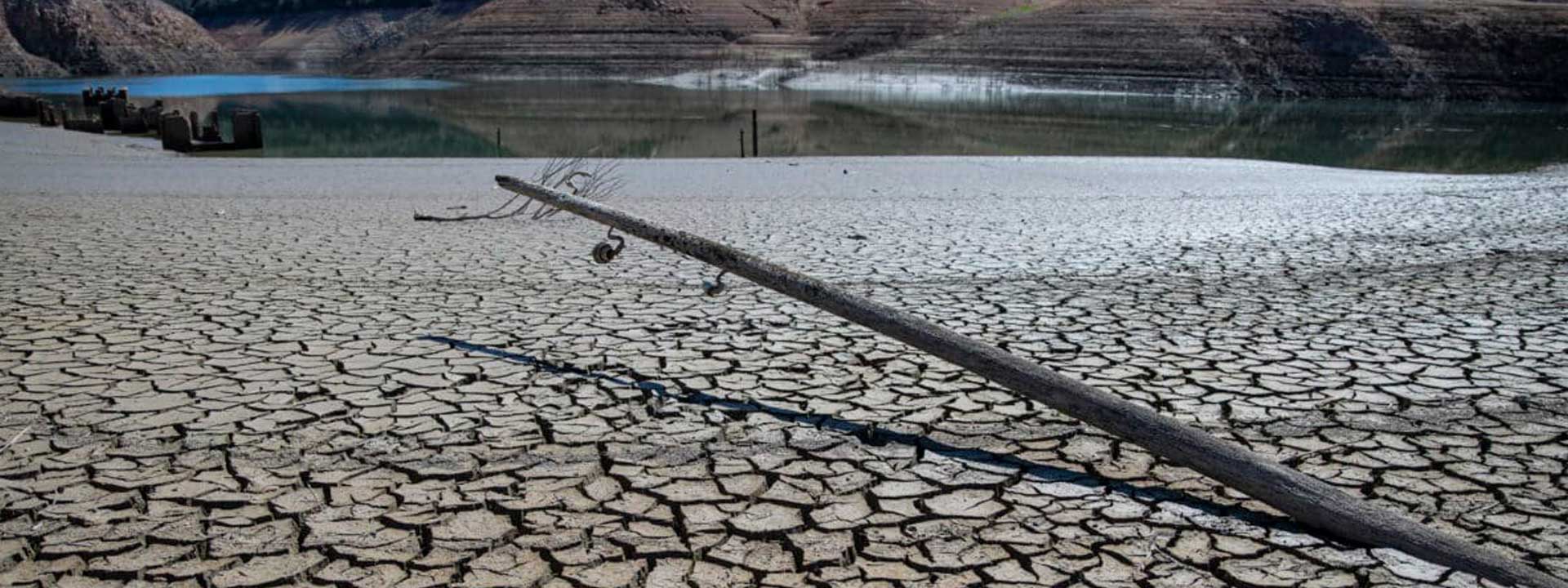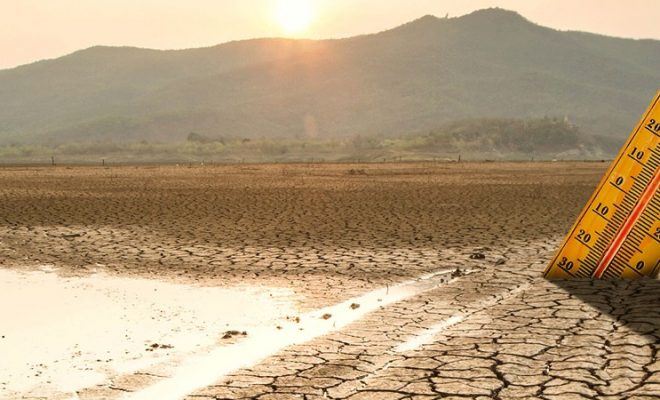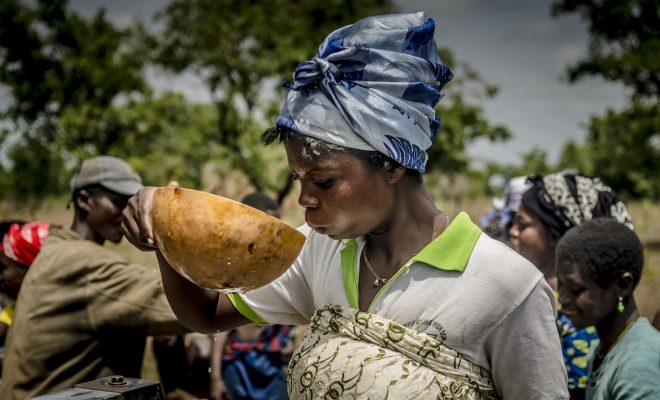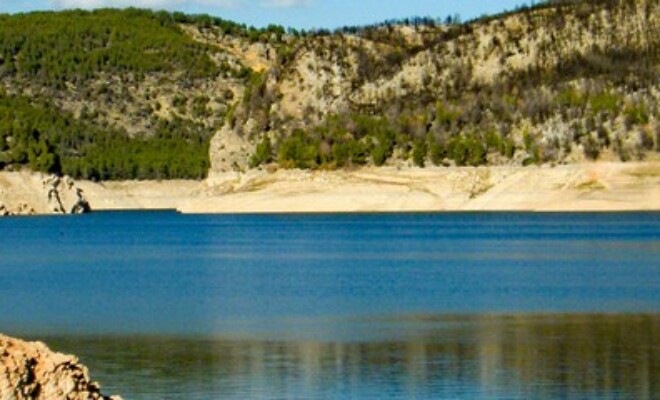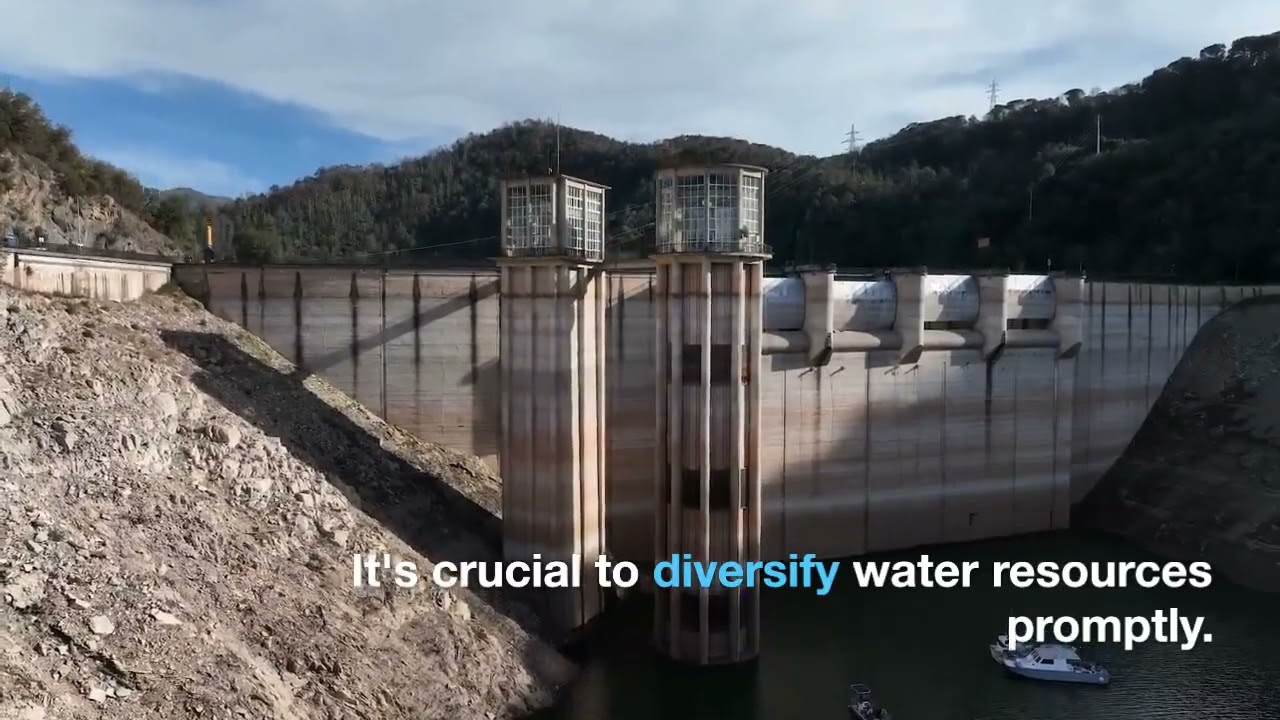
The Barcelona Metropolitan Area (BMA), with over two million residents, is the first urban region in southern Europe to face water restrictions prompted by severe drought conditions. This crisis also affects Catalonia’s internal basins, which provide water to the BMA’s population, agriculture, and natural habitats. Similar challenges are observed in other Mediterranean regions, including the southeastern Iberian Peninsula, Andalusia, southern France, and Italy.
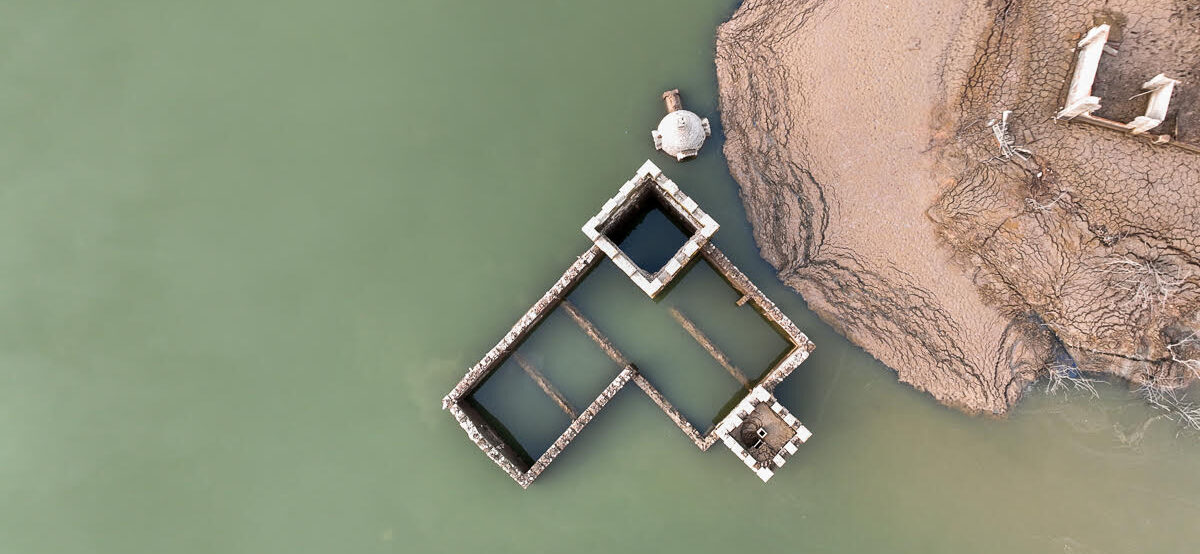
The water crisis currently unfolding in northeastern Spain is unlike anything seen in the past century. The strikingly low water levels in reservoirs like Sau clearly indicate the gravity of the situation. © Antoni Prat
Understanding the underlying factors contributing to this situation requires thorough examination.
Drought, the Triggering Factor
Over the past three years, the internal Catalan basins have experienced unprecedented scarcity in rainfall, breaking historical records. Across the entire region, the average rainfall during this period has been 300 millimeters, less than half of the average recorded over the last three decades. In January alone, only 15 millimeters of rainfall were recorded, significantly below the expected average of 150 millimeters.
Geographers and climatologists frequently employ the Standardized Precipitation Index (SPI) to evaluate rainfall patterns. This index indicates the deviation of rain and snowfall in a specific region compared to its historical average over different periods. The SPI serves as a valuable tool for assessing the intensity of extended drought periods and enables the creation of visually informative maps, such as these depicting rainfall anomalies in Catalonia:
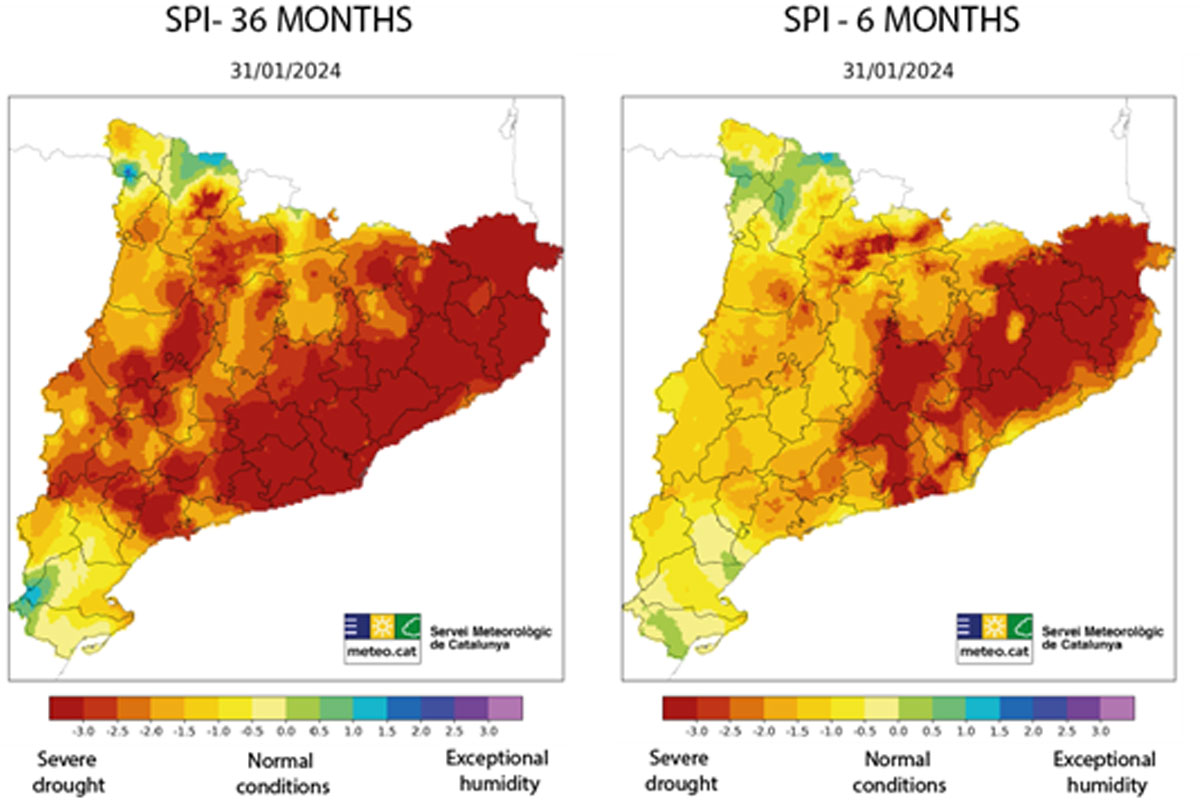
The SPI calculated over “long” intervals, typically exceeding 12 months, provides valuable insights into the impact of rainfall on groundwater, rivers, and reservoirs. Conversely, “short” intervals, typically less than nine months, are instrumental in estimating soil moisture levels. This information is crucial for assessing agricultural needs and forest conditions, as it offers more immediate insights into precipitation patterns.
The map on the left illustrates the SPI over a 6-month interval for Catalonia up to January 31, highlighting the low soil moisture levels attributed to drought conditions. On the right, the SPI is depicted over a 36-month period (three years), offering insights into the diminished water levels in aquifers, reservoirs, and rivers due to decreased rainfall. Source: Meteorological Service of Catalonia
Untimely Heat, an Aggravating Factor
The dire condition of the reservoirs in the internal Catalan basins vividly underscores the severity of the situation. The absence of rainfall has also translated into a lack of snowfall in the Pyrenean headwaters of the rivers. Another factor exacerbating the drought is the unusually high temperatures. During last autumn, particularly in November and December, the average temperature in the region and across the entire Mediterranean Arc and the Iberian Peninsula exceeded the regular seasonal averages. This uncharacteristic warmth has led to a significant increase in evapotranspiration from vegetation cover. Consequently, plants, responding to the heat, have required more water, drawing it from the already parched soil, further exacerbating the dryness.
In the middle of last January, Catalonia experienced a brief episode of moderate rainfall across most areas. Some regions received over 20 millimeters of precipitation, with snowfall occurring in the mountains. Despite this, rivers and reservoirs continued to lose water, barely benefiting from the rapid thaw when temperatures rose again. The arid soil acted as a sponge, impeding water absorption into the subsoil and rivers.
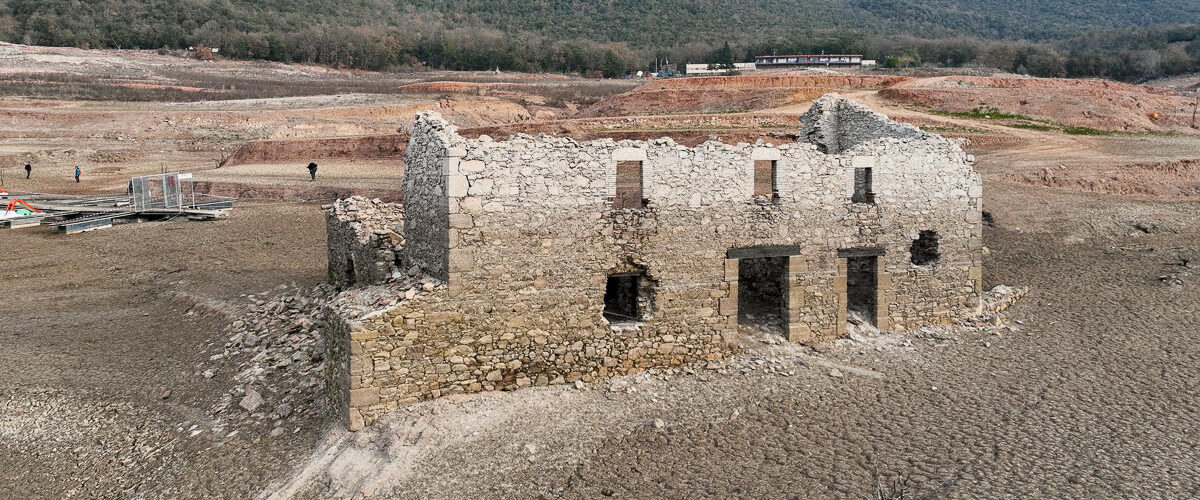
The historic village of San Romà de Sau resurfaces as the Sau reservoir experiences drought conditions. © Antoni Prat
Unusually high temperatures persisted during the first week of February in forested areas, with temperatures exceeding 20 degrees Celsius during the central hours of the day, whereas typical averages would be half that amount. On the 5th of this month, according to data from the Catalan Water Agency (ACA), water reserves in the internal basins of Catalonia were recorded at 15.59%, marking a historic low.
Hydrologists are sounding the alarm, cautioning that the dynamics of reservoirs will undergo significant changes. Traditionally, the thawing of the Pyrenees, where the headwaters of the Llobregat and Ter rivers originate, commences in May, accumulating water for use during the summer months. However, forecasts from the IPCC, which were previously accurate for the Mediterranean region, suggest that this pattern will be disrupted. These predictions indicate that climate change will reduce surface water resources and internal basins by approximately 12%. Additionally, a 9% decline in groundwater resources is projected. Moreover, there will be a surge in demand for agricultural and population uses.
Contamination of Aquifers, Another Factor
Another exacerbating factor is groundwater contamination from intensive agriculture and livestock farming, particularly pig farms. According to the Statistical Institute of Catalonia, there were nearly eight million pigs in the community as of 2022.
The ACA declares that nitrates, stemming from excessive slurry discharges, constitute the most significant form of diffuse pollution in groundwater, affecting surface water and, in some cases, coastal water bodies. The agency acknowledges that out of the 37 groundwater bodies in Catalonia, 17 are contaminated by nitrates. Furthermore, 46% of the total groundwater is affected by concentrations exceeding 50 mg/lt. The World Health Organization (WHO) recommends not consuming water with nitrate concentrations exceeding 25 mg/lt. Consequently, more than 40% of public fountains in inland regions of the community are typically labeled as “non-potable water.”
Like much of Spain, the livestock industry in Catalonia has been slow to invest in slurry treatment infrastructure. However, some biodigesters were developed to extract methane, water, and residual sludge from the slurry, which can then be repurposed as environmentally friendly fertilizers. Similar to the industrialization of the olive grove sector in Spain and Italy, livestock production tends to prioritize market-driven approaches.
“The First Thing That Rain Washes Away Is the Memory of Drought”
In 1990 and 2008, Barcelona faced droughts that nearly led to service restrictions. However, these crises were resolved at the last moment by timely and copious spring rains, which alleviated concerns among the public, leading to a rapid forgetfulness of the situation. Unfortunately, in both instances, the investments planned during the peak of the shortage, particularly in 2008, were either not implemented or only partially completed. Hydrologists and ecologists highlight this delay as exacerbating the current problem.
From an urban perspective in Barcelona, these plans involved activating and expanding the system to reuse water discharged by the El Prat treatment plant, diverting it upstream from the Llobregat River to the Sant Joan Despí drinking water treatment plant. However, this system remained unused until 2017. Additionally, desalination plants built after 2008, while valuable in emergencies, are inadequate in a system initially designed to rely on obtaining 80% of its water from the reservoirs of the Ter and Llobregat river network.
Emergency Solutions
The measures started with the declaration of emergency on February 2nd. They primarily focus on restricting daily water consumption per inhabitant to a maximum of 200 liters. This restriction is considered more than adequate, particularly in municipalities like Barcelona, where the average consumption is approximately 102.5 liters per person per day, one of the lowest rates in Europe. Additionally, the measures involve discontinuing the watering of parks, except for endangered trees, prohibiting the refilling of swimming pools, and implementing other restrictions in public facilities.
In the medium term, plans include transporting water via ships from the Sagunto desalination plant, with implementation expected by June. Additionally, there will be a focus on utilizing Barcelona’s groundwater resources, which have a capacity of between 20 and 25 cubic hectometers per year. Currently, the City Council holds a concession for 4.4 cubic hectometers but utilizes only 1.1, representing a quarter of its potential capacity. This water is primarily intended for municipal services like watering parks and street cleaning.
And Then? Desalination, Reuse, and Reducing Losses
Solid measures are urgently required to address the uncertainties posed by climate change. Relying solely on rainfall can no longer guarantee sufficient water for agricultural or urban needs. It is imperative to diversify water resources and promptly activate desalination and water reuse initiatives, which are emerging as inevitable options to confront a future marked by water storage crises in reservoirs and rivers.
The current water reuse system in the Llobregat basin can regenerate 2,000 liters per second out of the available 4,000 liters (water treated in El Prat). Extending this model to the Besós basin, where a similar volume of water is treated, is an urgent planned action. At the recent COP28, the Generalitat de Catalunya (Catalonia’s autonomous government) announced that Barcelona could be entirely supplied with reused water within four years.
Experts emphasize that increasing the production of the two desalination plants currently operational and installing additional plants are essential and long-overdue projects. Desalination has proven effective as an emergency solution in densely populated areas affected by droughts. The tourist influx to Barcelona and the Catalan coast, typical of the Mediterranean region, significantly exacerbates water stress during the hottest and driest seasons. While desalination is costly, advancements in renewables can potentially reduce energy-related expenses.
Another urgent action is reducing water losses in the extraction and supply processes, typically encompassed within the Non-Revenue Water (NRW) concept. Some municipalities in Catalonia are experiencing water losses of up to 40%, indicating an evident lack of investment in maintenance.
Hydrologists have also proposed creating infrastructures to harness water lost in urban runoff during heavy rainfall, particularly in coastal housing developments. This approach allows for the capture of water that could be treated for drinking purposes and significantly reduces sea pollution during such episodes. Implementing this strategy could yield up to 20% additional water resources.
Investing and Changing Mindsets
Climate-related crises consistently unveil a series of shortcomings, including inadequate planning, outdated infrastructure, project delays, and a general lack of awareness regarding water usage. These issues are often endemic in both industrialized and emerging regions within the Earth’s subtropical belt, particularly in areas experiencing significant population growth and continuous water stress over decades.
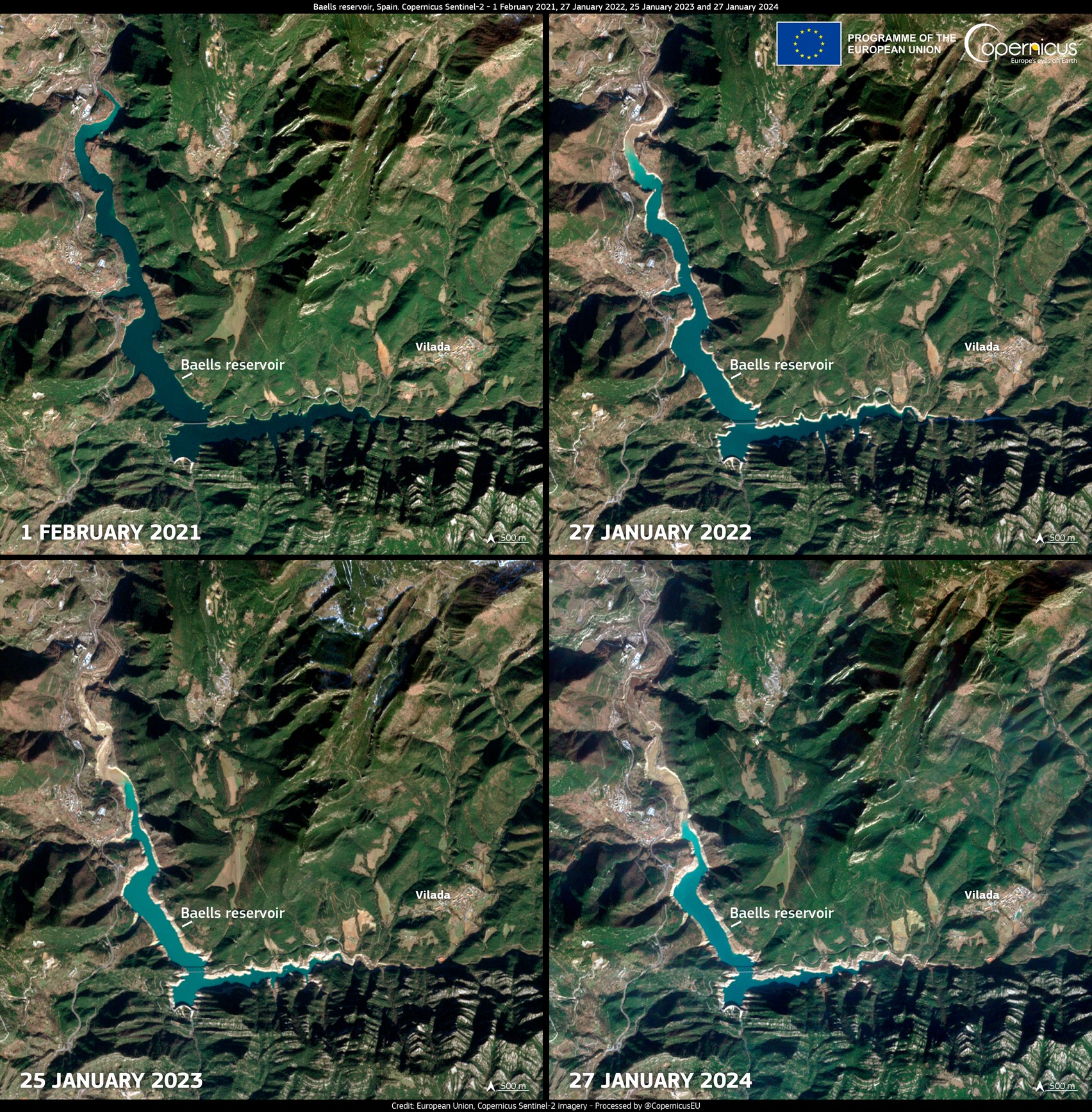
Satellite images depicting the Pyrenean reservoir of La Baells over the past three years. © Copernicus. The Europe’s Eyes on Earth.
Whether public or private investment is prioritized, or whether water charges are increased or the price of water consumption is raised, it is imperative to establish comprehensive hydrological plans to address the new climatic reality. Valuable insights can be gleaned from each triggering factor and potential solutions, informing crisis management strategies, as exemplified by the situation in Catalonia.


